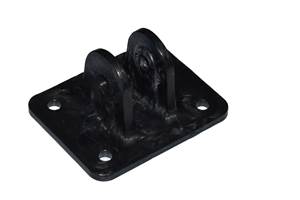NREL develops biomass-derived resin PECAN for wind blades
Demonstration and findings validate PECAN as a method for developing long blades that perform well with composites, outperform some resins and enable chemical recycling.
Researchers at the U.S. Department of Energy’s (DOE’s) National Renewable Energy Laboratory (NREL, Golden, Colo., U.S.), through the development of a novel sustainable resin, see a realistic path forward to the manufacture of bio-derivable wind blades that can be chemically recycled and the components reused.
The findings have been published in the new issue of Science. The resin, which is made of materials produced using bio-derivable resources, reportedly performs on par with the current industry standard of blades made from a thermoset resin and outperforms certain thermoplastic resins intended to be recyclable.
Using current manufacturing process methods and the NREL-developed biomass-derivable resin — which has been nicknamed “PolyEster Covalently Adaptable Network” or PECAN — researchers built a 9-meter prototype blade to demonstrate the resin’s manufacturability.
“Just because something is bio-derivable or recyclable does not mean it’s going to be worse,” says Nic Rorrer, one of the two corresponding authors of the Science paper.
Under existing technology, wind blades last about 20 years, and afterward they can be mechanically recycled such as shredded for use as concrete filler. PECAN is said to mark a leap forward because of the ability to recycle the blades using mild chemical processes, which enables blade components to be recaptured and reused again and again.
“It is truly a limitless approach if it’s done right,” says Ryan Clarke, a postdoctoral researcher at NREL and first author of the new paper. He adds that the chemical process was able to completely break down the prototype blade in 6 hours.
The paper, “Manufacture and testing of biomass-derivable thermosets for wind blade recycling,” involved work from investigators at five NREL research hubs, including the National Wind Technology Center and the BOTTLE Consortium. In the paper, researchers demonstrate an end-of-life strategy for the PECAN blades and propose recovery and reuse strategies for each component.
“The PECAN method for developing recyclable wind turbine blades is a critically important step in our efforts to foster a circular economy for energy materials,” says Johney Green, NREL’s associate laboratory director for mechanical and thermal engineering sciences.
Research into the PECAN resin began with the end. The scientists wanted to make a wind blade that could be recyclable and began experimenting with what feedstock they could use to achieve that goal. The resin they developed using bio-derivable sugars provided a counterpoint to the conventional notion that a blade designed to be recyclable will not perform as well.
“Just because something is bio-derivable or recyclable does not mean it’s going to be worse,” says Nic Rorrer, one of the two corresponding authors of the Science paper. He notes that one concern others have had about these types of materials is that the blade would be subject to greater “creep,” which is when the blade loses its shape and deforms over time. “It really challenges this evolving notion in the field of polymer science, that you can’t use recyclable materials because they will underperform or creep too much.”
Composites made from the PECAN resin held their shape, withstood accelerated weatherization validation and could be made within a timeframe similar to the existing cure cycle for how wind turbine blades are currently manufactured.
And while wind blades can measure the length of a football field, the size of the prototype provided proof of the process. “Nine meters is a scale that we were able to demonstrate all of the same manufacturing processes that would be used at the 60-, 80-, 100-meter blade scale,” says Robynne Murray, the second corresponding author.
The other co-authors, all from NREL, are Erik Rognerud, Allen Puente-Urbina, David Barnes, Paul Murdy, Michael McGraw, Jimmy Newkirk, Ryan Beach, Jacob Wrubel, Levi Hamernik, Katherine Chism, Andrea Baer and Gregg Beckham.
The U.S. DOE jointly funded the research through its Advanced Materials and Manufacturing Technologies Office and Bioenergy Technologies Office and its support of the BOTTLE Consortium. Additional research and funding will enable the investigators to build larger blades and to explore more bio-derived formulations.
Related Content
Hybrid process marries continuous, discontinuous composites design
9T Labs and Purdue applied Additive Fusion Technology to engineer a performance- and cost-competitive aircraft bin pin bracket made from compression-molded continuous and discontinuous CFRTP.
Read MoreWelding is not bonding
Discussion of the issues in our understanding of thermoplastic composite welded structures and certification of the latest materials and welding technologies for future airframes.
Read MoreCombining multifunctional thermoplastic composites, additive manufacturing for next-gen airframe structures
The DOMMINIO project combines AFP with 3D printed gyroid cores, embedded SHM sensors and smart materials for induction-driven disassembly of parts at end of life.
Read MoreDrag-based wind turbine design for higher energy capture
Claiming significantly higher power generation capacity than traditional blades, Xenecore aims to scale up its current monocoque, fan-shaped wind blades, made via compression molded carbon fiber/epoxy with I-beam ribs and microsphere structural foam.
Read MoreRead Next
Nlcomp receives half a million euros funding from Invitalia for recycled composites
Funding will help nlcomp commercialize patented rComposite recyclable composite solutions.
Read MoreMagnetic nanoparticles show promise for thermosets recycling
Aitiip and the University of Slovenia have collaborated to develop, test and prove how smart magnetic nanoparticles can produce a controlled decomposition of the resin for recycling.
Read MoreNREL integrates robotics into wind turbine blade production
Research enables successful automation in post-molding manufacturing operations, which could lead to more competitive U.S.-based blade manufacturing.
Read More


























